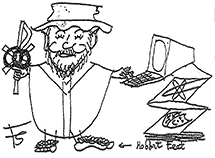Gregory Bateson was a noted anthropologist who later became very interested in the theory of communications. In the 1950’s one of his teaching assignments was with psychiatric residents at a mental hospital in California. His first assignment to his students was to write definItions of two important words: sacrament and entropy.
I was offering my class the core notions of 2,500 years of thought about religion and science. I felt that if they were going to be medical doctors of the human soul, they should at least have a foot on each side of the ancient arguments. They should be familiar with the central ideas of both religion and science. [G.Bateson, Mind and Nature, a Necessary Unity, Toronto, Bantam, 1980: pages 6-7 and Glossary]
Bateson was to develop severe criticism of what we would call the linear - straight-line - approach to thinking. This is in fact the common manner of thought picked up by science: it begins with assumptions (axioms), develops an argument, comes to a logical proof; that process in a sense always confirms what you would expect from the axioms. Two further things are needed for science to advance: an input of observations - experience - which is fed into the argument, and an understanding of difference between what you started with and what you discover. From this non-linear element he would come to describe information as ‘any difference which makes a difference.’
Entropy he describes as a condition is which things are mixed up, unsorted, undifferentiated, unpredictable and random. The opposite, in fact, of information, though he would further describe information as difference made by interrelationships and pattern.
Sacrament, Bateson describes as “the outward and visible sign of an inward and spiritual grace” - straight from The Book of Common Prayer!. A scientist who talks about grace.
If we are to apply Bateson’s initiation of his students into contemplating the poles of human reality as exemplified by entropy and sacrament, how would these apply to us now?
Clearly entropy alone would not signify much about human and animate nature: it would be the all-levelling background described in Newtonian mechanical terms. All life, human and animate, and geological and biological existence, are what is made of entropy by information, and information is that process by which we make a difference: nature indeed makes many differences by information processes, including our physical and spirited selves.
This nature, and human nature, thus advancing by making differences becomes creative: procreative, self-creative, communally creative. And the inward and spiritual grace which we come to experience in creativity, above all in interpersonal loving creativity, makes the world by outward and visible signs, a sacral universe, where we reach out further with our inward grace and outward signs to realities which are both the ultimate source and the ultimate destination of our being and existence.
Spiritual formation is the kind of information relationship which bonds one person to another; in religious terms, human persons to God. The external form of the bond is the nexus which affirms and confirms this relationship: the communal, thanksgiving act of a sacramental meal, the communal act of turning to God in Baptism (washing) and absolution - forgiveness, which is the bond of love.
In worship we renew ourselves and are transformed in relation to the Other. In the service of matrimony the words “with my body I thee worship” conveys some of this. The worshipper as a living system is changed to the extent of becoming part of a larger living system. But while that alone is true of any love relationship, in worship the formation is in relation to an Other of universal proportions.

